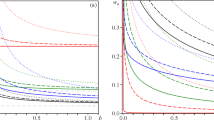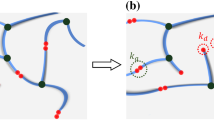Abstract.
Negative thixotropy, also called antithixotropy, is the effect of a flow-induced increase in viscosity that has been observed for many polymer solutions. Here, a simple quantitative model describing the time dependence of the shear stress or viscosity is presented. The model assumes a dynamic gel or network in the polymer solution, whose cross-links are dynamically formed and broken. The cross-links exist with or without deformation or flow of the solution. A second property of the model network is that it cannot be deformed infinitely, which is also true for any real network. The dynamic network solution is characterized by four parameters: its elastic shear modulus, its maximum degree of deformation, the rate with which the dynamic cross-links form and break and the viscous contribution of the polymer solution. The first two parameters can be related to each other, so only three independent parameters enter the model. An analytical solution is obtained which describes the flow-induced increase in viscosity, the minimum shear rate required for negative thixotropy and the dependence of the induction time on the shear rate. The results are shown to be in agreement with reported experimental results.
Similar content being viewed by others
Explore related subjects
Discover the latest articles and news from researchers in related subjects, suggested using machine learning.Author information
Authors and Affiliations
Additional information
Electronic Publication
Rights and permissions
About this article
Cite this article
Buitenhuis, .J., Pönitsch, .M. Negative thixotropy of polymer solutions. 1. A model explaining time-dependent viscosity. Colloid Polym Sci 281, 253–259 (2003). https://doi.org/10.1007/s00396-002-0768-y
Received:
Accepted:
Issue Date:
DOI: https://doi.org/10.1007/s00396-002-0768-y




